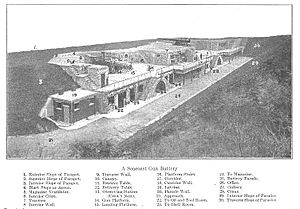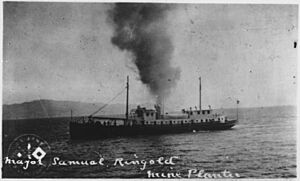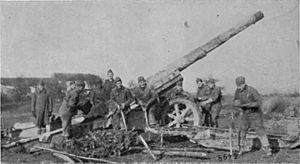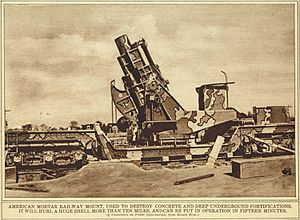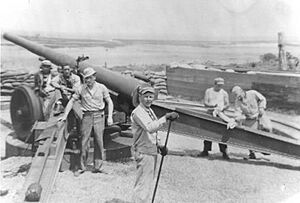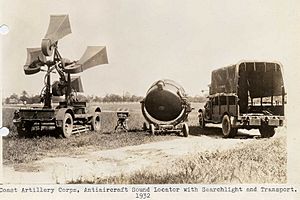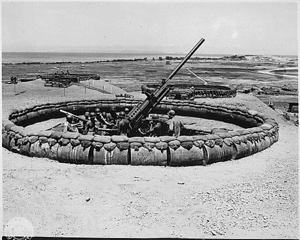United States Army Coast Artillery Corps facts for kids
Quick facts for kids U.S. Army Coast Artillery Corps |
|
|---|---|
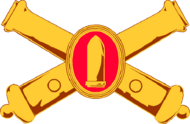 |
|
| Active | 1901–50 |
| Country | |
| Branch | |
| Garrison/HQ | Fort Monroe |
| Patron | Saint Barbara |
| Colors | Scarlet |
| Mascot(s) | Oozlefinch |
| Commanders | |
| Notable commanders |
Chiefs of Coast Artillery |
The U.S. Army Coast Artillery Corps (CAC) was a special group within the United States Army. From 1901 to 1950, their main job was to protect the United States and its lands. They did this by defending coasts, harbors, and by using anti-aircraft guns. The CAC also used very large guns, including ones on trains, during World War I.
Contents
History of Coastal Defense
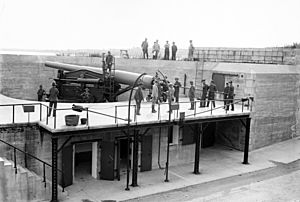
As early as 1882, people realized the U.S. needed strong, fixed guns to protect its coastlines. President Chester A. Arthur even mentioned this need to Congress.
In 1885, a group called the Endicott Board was formed. It was led by Secretary of War William Crowninshield Endicott. This group suggested a big plan to build defenses at 29 ports. These defenses included large guns, mortars, and mine fields. Most of these ideas were put into action, and new defenses were built between 1895 and 1905.
As these defenses were built, each harbor or river's defenses were managed by "Artillery Districts." These were later renamed "Coast Defense Commands" in 1913 and then "Harbor Defense Commands" in 1925. A special system was also created to help these forts aim their guns.
Changes in 1901
Army leaders understood that using huge, fixed guns needed different training than using smaller, mobile guns. Before 1901, all Army artillery units had both heavy and light guns. But in February 1901, the Artillery Corps was split into two parts: field artillery and coast artillery.
The old artillery units were broken up. Instead, 30 companies of field artillery and 126 companies of coast artillery were created. This new company-based setup allowed for more flexibility, as each harbor defense area had different needs. The Coast Artillery would change between using small companies and larger regiments many times over the years.
Underwater Mine Fields
Around 1901, the Coast Artillery also took over the job of setting up and using controlled mine fields. These mines were placed underwater, watched from shore, and could be set off by electricity. They were protected by the fixed guns. To do this, the Coast Artillery got special ships called "mine planters." These ships helped lay and maintain the mines and their cables. The mines were a very important part of coastal defense.
The Taft Board and the Coast Artillery Corps
In 1905, after the Spanish–American War, President Theodore Roosevelt formed a new board to look at fortifications. This board, led by William Howard Taft, updated some rules and checked the progress of the earlier defense plans. Most of their suggestions were about making technical improvements, like adding more searchlights and better ways to aim guns.
The board also suggested building defenses in new U.S. territories like Cuba, the Philippines, and Hawaii. Because very powerful new warships called dreadnought battleships were being built, a new 14-inch gun was introduced in some places. By the start of World War I, the U.S. had a coastal defense system that was as good as any other country's.
Because artillery technology was changing so fast, heavy coastal guns and lighter field guns became very different. In 1907, Congress officially separated the Field Artillery and Coast Artillery into their own branches. This created the separate Coast Artillery Corps (CAC). The Coast Artillery School was also established at Fort Monroe.
World War I and New Roles
When World War I started in Europe in 1914, the U.S. Army, including the Coast Artillery, was not fully ready. It had coastal guns but lacked other equipment. After the American entry into World War I, the Coast Artillery was given a huge new job: to provide soldiers for all U.S.-manned heavy artillery (guns 155mm and larger), most railway artillery, and later anti-aircraft artillery units.
Most of the heavy guns used by U.S. soldiers in France were made by France and Britain. Few American-made heavy guns arrived before the war ended. Coast Artillery units in France often worked alongside French forces. Many Coast Artillery companies from U.S. coast defenses were sent to France to help form new artillery units.
The U.S. did not have any railway guns when it entered World War I. So, the Army used French-made railway guns. The U.S. Navy also built and used five large 14"/50 caliber railway guns. The Army also started converting some of its own large coastal guns to be used on railway mounts. These railway guns could move along train tracks to different locations.
After the war, some of the railway guns were kept, but most of the large coastal guns were returned to their fixed positions in forts.
On July 9, 1918, the Army Mine Planter Service was created as part of the Coast Artillery Corps. This meant that military officers and engineers, called Warrant Officers, would now operate the mine planter ships instead of civilians.
Between the World Wars
After World War I, most of the wartime artillery units were disbanded. Only a few remained, including some railway gun units and units with 155 mm guns. These 155mm guns could be moved by heavy tractors, which meant the Coast Artillery could now defend areas not covered by fixed harbor defenses. Special circular concrete platforms called "Panama mounts" were built to help these mobile guns.
The job of railway artillery became a permanent role for the Coast Artillery. The anti-aircraft mission also continued, with units in the U.S., Philippines, and Hawaii.
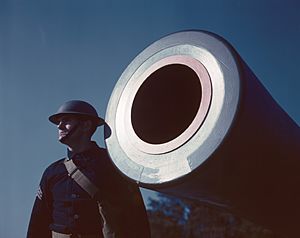
Because battleships kept improving, the Coast Artillery got some new 16-inch (406mm) and 14-inch (356mm) guns. These huge guns could shoot very far. However, only a few of these were built and placed in locations like Los Angeles, the Philippines, Hawaii, and Panama by 1940.
A more common gun from this period was the 12-inch gun M1895 on a new, high-angle carriage. This carriage allowed the gun to shoot much farther than before. Thirty of these guns were placed in 16 batteries by 1924.
In 1922, Filipino soldiers, called Philippine Scouts, formed their own coast artillery units. They helped protect the defenses in the Philippines until 1942. Also in 1922, the Journal of the United States Artillery was renamed the Coast Artillery Journal.
In 1923-1924, the Coast Artillery started using a regimental system for all its units, including the Regular Army, National Guard, and Organized Reserve. This system lasted until World War II. In 1925, Coast Defense Commands were renamed Harbor Defense Commands.
By the late 1920s, many harbor defenses in less threatened areas were completely disarmed. Their guns were removed.
The new 16-inch and 12-inch gun batteries built in the 1920s were in open areas. This meant they were not protected from air attacks. This problem was fixed by building strong concrete shelters, called casemates, around most of the newer batteries early in World War II.
World War II and Its Impact
The start of World War II in Europe in 1939 and the fall of France in 1940 made the U.S. speed up its defense plans. Around this time, the Navy released about 50 large 16-inch guns to the Army. In 1940, the Army suggested building 38 new 16-inch gun batteries along the U.S. coast. These would be protected from air attacks. However, as the war went on, the threat from enemy ships decreased, so only 21 of these batteries were finished.
The 16-inch guns were just one part of the World War II defense plan. This plan aimed to replace almost all older coastal defense weapons with newer ones. Each harbor defense area was planned to have long-range 16-inch or 12-inch guns, plus 6-inch guns and smaller 90 mm Anti Motor Torpedo Boat (AMTB) guns. By late 1941, about 45,000 soldiers were working in harbor defense. By mid-1943, this number reached 70,000. As new defenses were completed, many older guns were removed and their crews were sent to other artillery units.
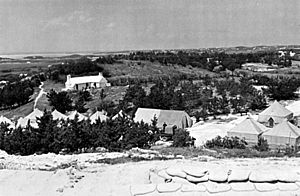
- Bermuda's Role
Before the U.S. entered World War II, American forces were allowed to go to Bermuda. This was part of an agreement with Britain. Bermuda was a very important place for the British Navy and for convoys crossing the Atlantic Ocean. Although Bermuda had many old forts, most of its guns were outdated. So, American artillery units were sent there to help defend the island. They brought 155mm GPF guns on wheels, which were placed on "Panama mounts." After the war, all U.S. Army defenses outside the leased bases were removed from Bermuda.
- After Pearl Harbor
The attack on Pearl Harbor in December 1941 showed that the Coast Artillery's anti-aircraft defenses were not enough against a large air attack. The coastal defense guns, designed to stop ships, were also not very useful against planes.
When the Japanese invaded the Philippines, the Harbor Defenses of Manila and Subic Bays were involved in the fighting. The Coast Artillery soldiers did their best, but their guns were not in good positions to fight the enemy attacks and were open to air attacks. For example, eight 8-inch railway guns had been sent to the Philippines, but six were destroyed by air attacks. The U.S. and Filipino forces surrendered in May 1942.
During the war, the Coast Artillery focused on two main things: getting more soldiers and updating their equipment. The National Guard was called into service in 1940. The main anti-aircraft gun was upgraded from the 3-inch gun M3 to the 90 mm gun M1. Except for the early fighting in the Philippines, the anti-aircraft branch was the Coast Artillery's only part fighting on the front lines of World War II.
Only twice did a U.S. military base in the continental U.S. come under attack after 1895. These were the bombardments of Dutch Harbor, Alaska, and Fort Stevens, Oregon, by the Imperial Japanese Navy in June 1942. At Dutch Harbor, Japanese planes caused some damage. At Fort Stevens, a Japanese submarine fired at the fort, but the fort's commander did not fire back because the submarine was out of range.
In late 1942, the War Department decided that older or less physically fit soldiers would staff harbor defense and anti-aircraft units in the U.S. This freed up younger, fitter soldiers for frontline combat.
In 1943–44, the Coast Artillery regiments were broken up into smaller battalions. Many former Coast Artillery units became heavy field artillery units. By 1944, with most of the new defenses built and naval threats reduced, work on new batteries stopped. Most of the older guns were scrapped, and the Coast Artillery Corps became much smaller.
After the war, it was decided that very few gun defenses were needed. By 1948, almost all coastal defenses were gone. With only the anti-aircraft mission left, the Coast Artillery was officially ended in 1950. The anti-aircraft and field artillery branches were combined. Today, the Air Defense Artillery continues the history of the Coast Artillery, including using the Oozlefinch mascot.
Chiefs of Coast Artillery
The leader of the Coast Artillery was called the Chief of Coast Artillery. This role was created in 1908 and ended in 1942.
| Image | Rank | Name | Begin Date | End Date |
|---|---|---|---|---|
 |
Major General | Arthur Murray | 1 July 1908 | 14 March 1911 |
 |
Major General | Erasmus M. Weaver Jr. | 15 March 1911 | 28 May 1918 |
 |
Major General | Frank W. Coe | 29 May 1918 | 19 March 1926 |
 |
Major General | Andrew Hero Jr. | 20 March 1926 | 21 March 1930 |
 |
Major General | John W. Gulick | 22 March 1930 | 21 March 1934 |
 |
Major General | William F. Hase | 26 March 1934 | 20 January 1935 |
 |
Major General | Harry L. Steele | 21 January 1935 | 31 March 1936 |
 |
Major General | Archibald H. Sunderland | 1 April 1936 | 31 March 1940 |
 |
Major General | Joseph A. Green | 1 April 1940 | 9 March 1942 |
Units and Organization
In 1901, the Army changed how its artillery units were set up. Instead of regiments, they created many numbered companies.
- 126 companies for heavy (coast) artillery
- 30 companies for light (field) artillery
In 1907, the Coast Artillery Corps was officially formed. During World War I, the Corps created 61 regiments and 16 brigade headquarters. Many of the numbered companies provided the core soldiers for these new units. These units served with the American Expeditionary Forces (AEF) in France, operating heavy and railway artillery. Most of these units were disbanded right after the war.
Also during World War I, the anti-aircraft branch was born. This job was officially given to the Coast Artillery Corps in 1920.
In 1924, the Coast Artillery Corps went back to using a regimental system. The numbered companies were renamed with letter designations (like Company A, Company B). To build team spirit, the first seven regiments were given the history of the original seven artillery regiments.
The Coast Artillery Corps had different types of regiments:
- Harbor Defense (HD) regiments: These protected harbors.
- Tractor-Drawn (TD) regiments: These used 155mm guns pulled by tractors, making them mobile.
- Railway (RY) regiments: These used guns mounted on trains.
- Anti-Aircraft (AA) regiments: These protected against air attacks.
The Regular Army, National Guard, and Organized Reserve all had these types of units. However, many Reserve units had few soldiers and struggled with training.
Changes During World War II
When the U.S. entered World War II, more regiments were created and existing ones were mobilized. For example, the 24th Coast Artillery was sent to Newfoundland, and the 27th Coast Artillery Battalion went to Bermuda.
During the war, the Japanese invasion of the Philippines led to the surrender of U.S. forces there in 1942. This included several Coast Artillery units.
In 1943-44, the anti-aircraft regiments were broken up into smaller battalions. The harbor defense regiments were also broken up in late 1944. This was part of a larger Army-wide change where most units, except infantry, became battalions instead of regiments. The term "coast artillery" was removed from the anti-aircraft units' names around this time.
As a result of these changes, many new units were created, including:
- Coast Artillery Battalions
- Anti-aircraft Artillery Battalions
- Anti-aircraft Artillery Automatic Weapons Battalions
- Anti-aircraft Artillery Gun Battalions
- Anti-aircraft Artillery Searchlight Battalions
- Barrage Balloon Battalions
By April 1945, most of the remaining coast artillery battalions (not anti-aircraft) were closed down. Their soldiers were either moved to other harbor defense commands or sent to field artillery units.
Coast Artillery School
The Coast Artillery School had a special symbol.
- Description: It was a gold metal and enamel design, about 1 inch tall. It looked like a shield, split horizontally with red on top and blue on the bottom. On the red part was the Coast Artillery symbol: a cannon crossed with an artillery shell, all in gold. On the blue part was a gold submarine mine.
- Motto: "Defendimus" (We Defend).
- Symbolism: The red and blue shield with a wavy line represented the land and sea. The artillery symbol showed their main job, and the submarine mine showed their work with underwater defenses. Two cannons were also used as supporters for the shield.


